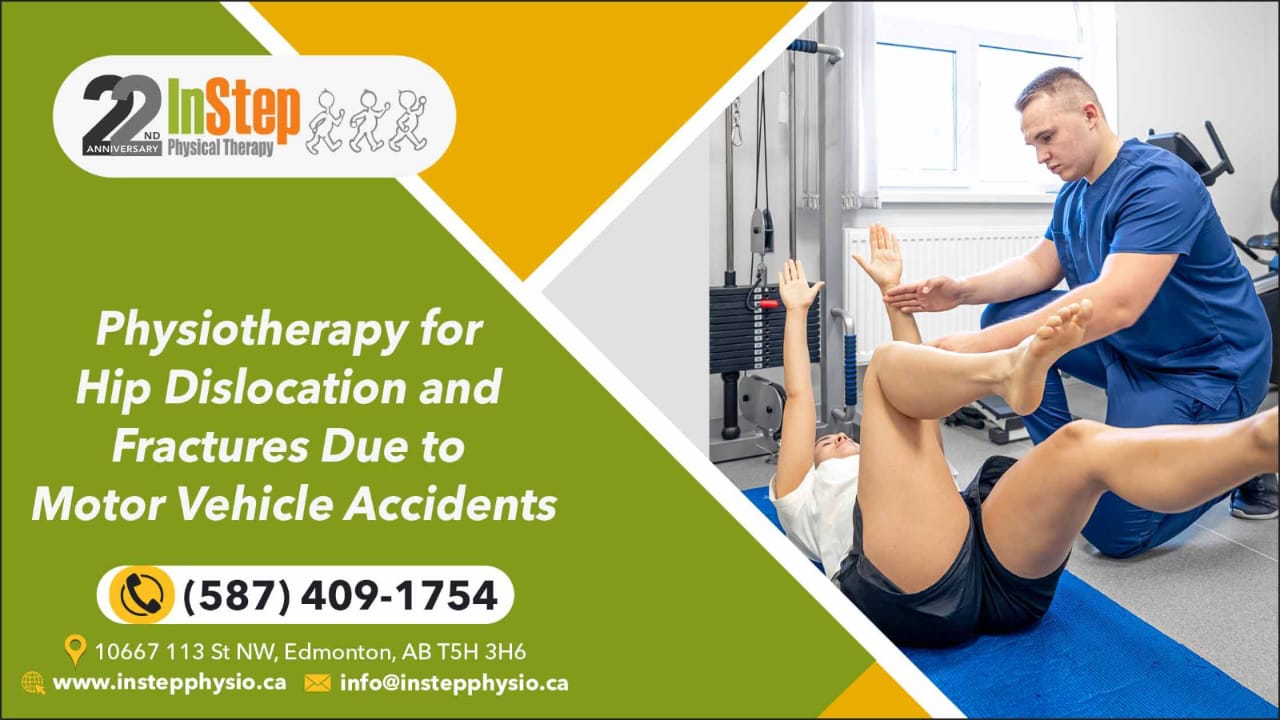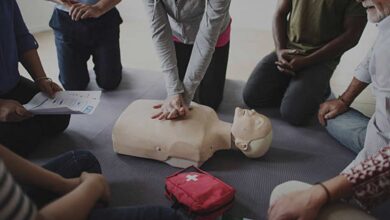Motor vehicle accident (MVA) physiotherapy aims to treat injuries sustained as a result of vehicle accidents. Motor vehicle accident physiotherapy in Edmonton focuses on assessing and addressing musculoskeletal injuries, such as whiplash, back pain, fractures, and soft tissue injuries, that may occur due to the impact of a motor vehicle crash. The goals of MVA physiotherapy are to reduce pain, restore function and mobility, promote healing and tissue recovery, and facilitate the patient’s return to their pre-injury level of activity and function.
Physiotherapy Approaches for Treating Hip Dislocations and Fractures Resulting from Motor Vehicle Accidents:
Motor vehicle accident physiotherapy in Edmonton plays a vast role in the rehabilitation process for individuals who have experienced hip dislocation or fractures due to motor vehicle accidents. Here’s a general overview of how car accident physiotherapy can be structured for such cases:
Pain Management:
Initially, managing pain is often a primary focus. This may involve modalities such as ice or heat therapy, electrical stimulation, or manual techniques to reduce inflammation and alleviate discomfort. Techniques commonly used:
Electrical Stimulation:
Techniques such as Transcutaneous Electrical Nerve Stimulation can be used to reduce pain. TENS units emit small electrical pulses to the skin to interfere with the transmission of pain signals to the brain.
Manual Therapy:
Physiotherapists may employ gentle joint manipulations or mobilizations to decrease pain and improve joint function. This might also include soft tissue massages to alleviate muscle tension. Here are some common manual therapy techniques used in such cases:
Joint Mobilizations:
Graded Mobilizations: Gentle, rhythmic joint movements applied at different speeds and amplitudes to increase joint mobility and reduce pain.
Sustained Mobilization: Applying a slow, steady pressure to the hip joint or surrounding joints to gradually increase the range of motion.
Manipulation:
High-Velocity, Low-Amplitude Thrusts: Performed less frequently and only when deemed safe, these are quick, precise movements aimed at restoring normal joint mechanics and reducing pain instantly.
Soft Tissue Techniques:
Massage: Various massage techniques, such as effleurage (light strokes) and petrissage (kneading), focus on reducing muscle tension and promoting circulation to the affected areas.
Myofascial Release: Targeted pressure is applied to the myofascial connective tissue to reduce restrictions and improve tissue mobility.
Neuromuscular Techniques:
Trigger Point Therapy: Exerting pressure to specific points within a muscle to reduce localized and referred pain.
Manual Traction:
Applying a gentle pulling force to the leg to decrease compression forces in the hip joint can help alleviate pain and improve mobility.
Range of Motion Exercises:
Gentle exercises aimed at reestablishing the normal range of motion in the hip joint will be introduced gradually. These may include passive movements performed by the therapist initially and later progressed to active movements performed by the patient.
Active Range of Motion Exercises:
Standing Hip Flexion: Lifting the knee towards the chest without exceeding the pain-free range.
Standing Hip Abduction: Lifting the leg to the side, away from the body, while maintaining balance.
Seated Knee Raises: Lifting the knee up and down while seated on a chair helps in increasing hip flexion.
Advanced Range of Motion Exercises:
Hip Circles: Making circular movements with the leg, both clockwise and counterclockwise, to enhance hip mobility in multiple directions.
Side Leg Raises: Lifting the leg sideways while lying on the opposite side strengthens the muscles around the hip and improves joint function.
Strength Training:
Exercises to strengthen the muscles encircling the hip joint, including the hip flexors, abductors, extensors, adductors, and gluteal muscles, are essential for improving stability and function. These exercises will be tailored to the individual’s specific needs and may incorporate resistance bands, weights, or bodyweight exercises. A common strength training exercise used:
Isometric Exercises:
Hip Squeezes: Pressing the knees together using a ball or pillow between them can strengthen adductors.
Gluteal Sets: Tightening the buttocks and holding the contraction helps to activate and strengthen the gluteal muscles.
Balance and Proprioception Training:
Balance and proprioception exercises help enhance stability and decrease the risk of falls. This may involve activities like standing on one leg, using balance boards or stability balls, and performing functional movements that challenge balance and coordination.
Tandem Stance: Positioning one foot directly in front of the other to challenge balance further. This can also be done along a line on the floor to mimic walking a tightrope.
Stability Ball Exercises: Sitting or lying on a stability ball and performing various movements such as leg lifts or arm movements to engage core muscles and improve balance.
Functional Rehabilitation:
As the individual progresses, the focus shifts towards more functional activities that mimic daily tasks and activities specific to their needs and goals. This may include walking, stair climbing, getting in and out of a car, and other activities relevant to their daily life and work.
Walking Exercises:
Controlled Walking: Initially, aids like walkers or crutches are used to ensure safe and proper gait mechanics.
Treadmill Walking: Controlled environment to adjust speed and incline to challenge the patient progressively.
Transitional Movements:
Sit-to-Stand: Practicing getting up from a seated position without using hands, focusing on using leg and hip strength.
Car Transfer Techniques: Training on how to get in and out of a car using safe movements that minimize hip strain.
Maximizing Recovery:
Motor vehicle accident physiotherapy in Edmonton is critical in the process of recovery for individuals who have sustained hip dislocations and fractures from motor vehicle accidents. In Step Physical Therapy in Edmonton not only aids in the immediate recovery of joint function and pain reduction but also facilitates a gradual return to daily activities, work, and recreational pursuits. Regular assessment and adaptation of the treatment plan are crucial for addressing the changing needs of the patient and ensuring the best outcomes.
Overall, successful rehabilitation requires a multi-faceted approach, combining professional guidance, patient education, and active participation from the patient, all aimed at restoring function and improving quality of life after a traumatic event such as a motor vehicle accident.








